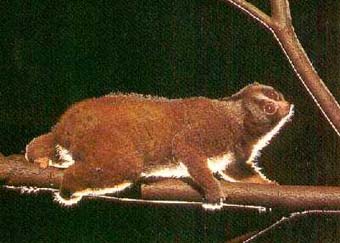
|
|
General Information
Length of head and body 10.5 to 15 inches (25-40cm). Weights approximately 1 kg and about the size of a small rabbit.
Slow lorises have a vestigial tail. The second digit on their hands is reduced in size, and the big toe on the hind foot is set well apart from the other toes, allowing greater gripping power.
The slow loris has a long, curved claw on the second toe which sticks up and is used to scratch the skin.
Lorises also have more vertebrae in their backs, giving them a greater tree climbing advantage since they can twist around and below branches with wide range and extension of movement.
The slow loris is covered with short, thick, woolly fur, which is found in a wide variety of colours and patterns. Generally, the colour varies from ash-gray to white with a dark dorsal and dark rings around the eyes.
Habitat
Found in rainforest of Southeast Asia, western Indonesia and East Indian
Islands. Slow lorises are arboreal primates, occupying the canopies of rainforest
most of their times. But when on ground, they will move with a wavering
trot.
Feeding and Breeding
Slow lorises are nocturnal predators and feed mainly on fruits, with occasional insects, bird eggs and young or sleeping birds and small mammals.
They move slowly towards their prey so as not to alert and frighten it away, but once they are within striking distance, it will strike and subdue their prey.
The grip of the slow lorisŐs hind feet is so strong that it often gathers food hanging upside down using its front hands to capture and hold prey.
Slow lorises are mainly solitary and, like many nocturnal prosimians, mark trees with their urine to communicate territory and reproductive status. This is done by urinating on their hands and then wipes it onto tree branches. Male territories often overlap those of several females.
Slow lorises reproduce every 12 to 18 months, giving birth generally to one offspring.
Young are gray with silvery-white limbs and hands. This coloration darkens to that of an adult at 11 weeks.
Infants cling to their motherŐs belly when first born, but quickly descend or nest where they will remain hidden while their mother is foraging.
Slow lorises reach sexual maturity at 18 months and gestation period lasts about 190 days. Their life span is 20 years, as observed in captivity.
Conservation
Status of the slow loris is endangered. The primary threats to the survival of the slow loris are habitat destruction and capture for pet trade.
Interesting Facts
Slow Lorises are completely nocturnal and sleep during the day rolled up like a ball with their head between their legs. Despite their slow movements, slow lorises are capable of rapid movement especially when disturbed or in search of foods. They will make sharp twittering noises when annoyed.
When threatened, slow lorises will exude a strong smelling substance that can be toxic when combined with their saliva. The scent warns predators of a foul taste awaiting them if they attempt to bite the loris. Thus, mother lorises also lick on their infants to protect them the same way.
Insight
The best time to view them is shortly after sunset. They are usually found hanging on the branch in front of the exhibit , grooming themselves and displaying their acrobatic skills! Although they are omnivorous, their diet in he Night Safari is strictly fruit( I don't think so!).
This website is best viewed using Internet Explorer at 800 X 600 resolution